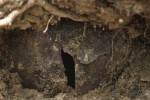 In August of 1832, a group of 57 Irish immigrants started work on a section of the Philadelphia and Columbia railroad known as a cut 20 miles west of Philadelphia. A few weeks later, they were all dead, most probably from cholera. Philip Duffy, the man who hired the Irish workers, had the shanty they slept in burned to keep disease from spreading and the dead buried in the railroad fill. Their families were never notified.
In August of 1832, a group of 57 Irish immigrants started work on a section of the Philadelphia and Columbia railroad known as a cut 20 miles west of Philadelphia. A few weeks later, they were all dead, most probably from cholera. Philip Duffy, the man who hired the Irish workers, had the shanty they slept in burned to keep disease from spreading and the dead buried in the railroad fill. Their families were never notified.
William Watson, chairman of History at Immaculata University, and his brother Frank have been searching for the remains for nigh on a decade. They learned of the story in 2002 from papers their grandfather — a lifelong employee of the railroad — left behind. It wasn’t until March 2009 that they came upon a shin bone, and in the year since then they’ve recovered 7 sets of human remains.
Most surprisingly, the brothers think they’ve actually identified one of the deceased. The manifest of the ship John Stamp, which sailed from Ireland to Philadelphia 4 months before the tragedy, lists 15 possible workers who came from Donegal, Tyrone and Derry counties. One of them was 18-year-old John Ruddy. The Watsons found remains that suited Ruddy’s age, but they also got a hugely lucky break when they found the jaw was missing an upper molar that never formed. This is a rare genetic mutation which members of the Ruddy family in Ireland today share. It will take some months for DNA confirmation, but so far all signs point to Ruddy.
The Watsons and their team think there may have been more than cholera behind all these dead men.
The brothers have long hypothesized that many of the workers succumbed to cholera, a bacterial infection spread by contaminated water or food. The disease was rampant at the time, and had a typical mortality rate of 40 percent to 60 percent.
The other immigrants, they surmise, were killed by vigilantes because of anti-Irish prejudice, tension between affluent residents and poor transient workers, or intense fear of cholera — or a combination of all three.
Now, their theory is supported by the four recovered skulls, which indicate the men probably suffered blows to the head. At least one may have been shot, said Janet Monge, an anthropologist working on the project.
“I don’t think we need to be so hesitant in coming to the conclusion now that violence was the cause of death and not cholera, although these men might have had cholera in addition,” Monge said.
Other artifacts found on the site include working tools, nails, cooking and eating utensils and Irish pipes. Read more about the Duffy’s Cut excavation on the project website.